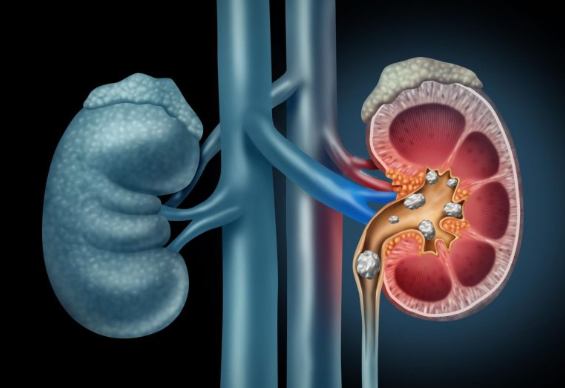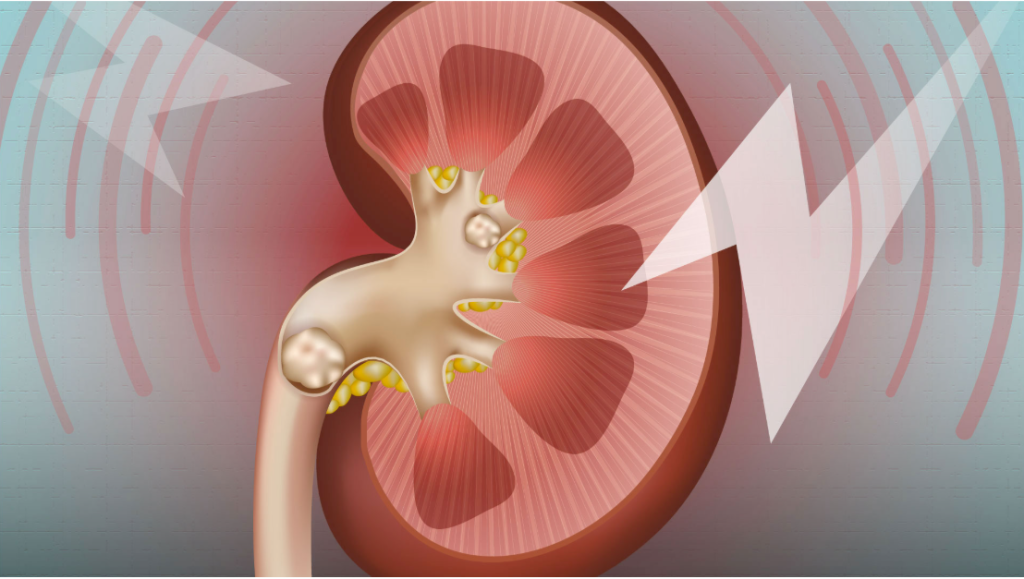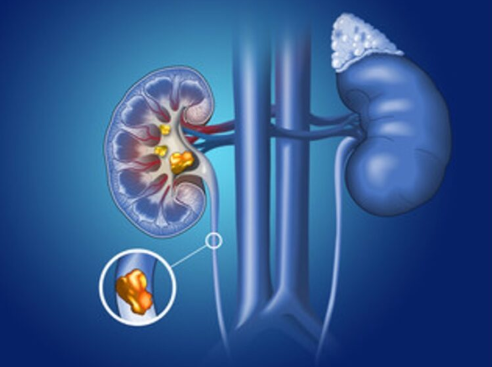Kidney stones are hard deposits made of minerals and salts that form inside your kidneys. They can affect any part of your urinary tract — from your kidneys to your bladder. Stones form when the urine becomes concentrated, allowing minerals to crystallize and stick together.

1. Calcium Stones (Most Common)
- Subtypes:
- Calcium oxalate – the most common type.
- Calcium phosphate – less common, sometimes linked to metabolic conditions.
- Causes: High calcium or oxalate in urine, dehydration, certain diets.
- Prevention:
- Stay hydrated.
- Limit high-oxalate foods (e.g., spinach, nuts, chocolate).
- Maintain a balanced calcium intake (not too low, not too high).
2. Struvite Stones
- Composition: Magnesium ammonium phosphate.
- Causes: Usually form in response to urinary tract infections (UTIs).
- Characteristics: Can grow quickly and become large, sometimes called “staghorn calculi.”
- Prevention: Promptly treat urinary tract infections.
3. Uric Acid Stones
- Causes: High uric acid levels, acidic urine, gout, or high-purine diet (red meat, organ meat, shellfish).
- Characteristics: Can sometimes be dissolved with medications or urine alkalization.
- Prevention:
- Drink plenty of water.
- Reduce intake of purine-rich foods.
- Maintain normal urine pH.
4. Cystine Stones
- Cause: Genetic disorder called cystinuria (kidneys excrete too much cystine).
- Characteristics: Rare, tend to recur.
- Prevention/Treatment:
- Drink lots of water.
- Medications to reduce cystine levels in urine.

The Symptoms of Kidney stone
1. Pain (Most Common Symptom)
- Often sudden and severe, known as renal colic.
- Location:
- Side or back, below the ribs (flank pain)
- Pain can radiate to the lower abdomen, groin, or genitals
- Nature:
- Comes in waves and fluctuates in intensity
- Can be extremely intense, sometimes described as one of the worst pains experienced
2. Urinary Symptoms
- Pain or burning during urination (dysuria)
- Frequent urination or urgency
- Cloudy or foul-smelling urine
- Feeling like you can’t completely empty your bladder
3. Blood in Urine (Hematuria)
- Urine may appear pink, red, or brown
- Blood may be visible to the naked eye or only detected on a urine test
4. Gastrointestinal Symptoms
- Nausea and vomiting
- Abdominal discomfort or bloating
5. Other Signs
- Fever and chills (may indicate a urinary tract infection along with a stone; this is a medical emergency)
- Small stones may cause no symptoms and are often discovered incidentally during imaging for another reason
Red Flag Symptoms (Seek Immediate Medical Attention)
- Severe, unbearable pain
- Fever with chills
- Persistent vomiting
- Blood in urine that doesn’t clear
- Difficulty urinating or no urine output

The treatment for kidney stones
1. Small Stones (Usually <5 mm)
- Most pass on their own with supportive care.
- Treatment includes:
- Drinking plenty of water (2–3 liters/day) to help flush the stone
- Pain management: NSAIDs (like ibuprofen) or acetaminophen
- Medications to relax the ureter and help the stone pass, such as alpha-blockers (e.g., tamsulosin)
- Time to pass: Usually a few days to a few weeks
2. Large Stones or Stones Causing Blockage
When stones are too large to pass naturally or cause complications (like infection or kidney damage), procedures may be required:
A. Extracorporeal Shock Wave Lithotripsy (ESWL)
- Uses sound waves to break stones into smaller pieces that can pass in urine
- Non-invasive, usually outpatient
- Best for stones in the kidney or upper ureter
B. Ureteroscopy
- A small scope is inserted through the urethra and bladder into the ureter to locate and remove or break up the stone
- Can be done for stones in the ureter or kidney
- May involve a temporary stent to aid urine flow
C. Percutaneous Nephrolithotomy (PCNL)
- Minimally invasive surgery through a small incision in the back
- Used for very large stones or complex “staghorn” stones
- Usually requires hospitalization
D. Open Surgery
- Rare today, only used for extremely large or complicated stones that cannot be treated otherwise
3. Medications
- Pain relief: NSAIDs or opioids in severe cases
- Medications to prevent stone formation:
- Allopurinol – for uric acid stones
- Thiazide diuretics – for calcium stones
- Potassium citrate – to alkalize urine and prevent uric acid or cystine stones
4. Lifestyle and Home Care
- Stay well-hydrated to prevent new stones
- Limit salt and animal protein
- Follow diet recommendations based on stone type (e.g., low oxalate for calcium oxalate stones)
- Maintain a healthy weight and exercise regularly
5. Emergency Situations
Immediate medical attention is needed if:
- Severe pain that doesn’t improve with painkillers
- Fever and chills (possible infection)
- Blood in urine with vomiting
- Inability to urinate
